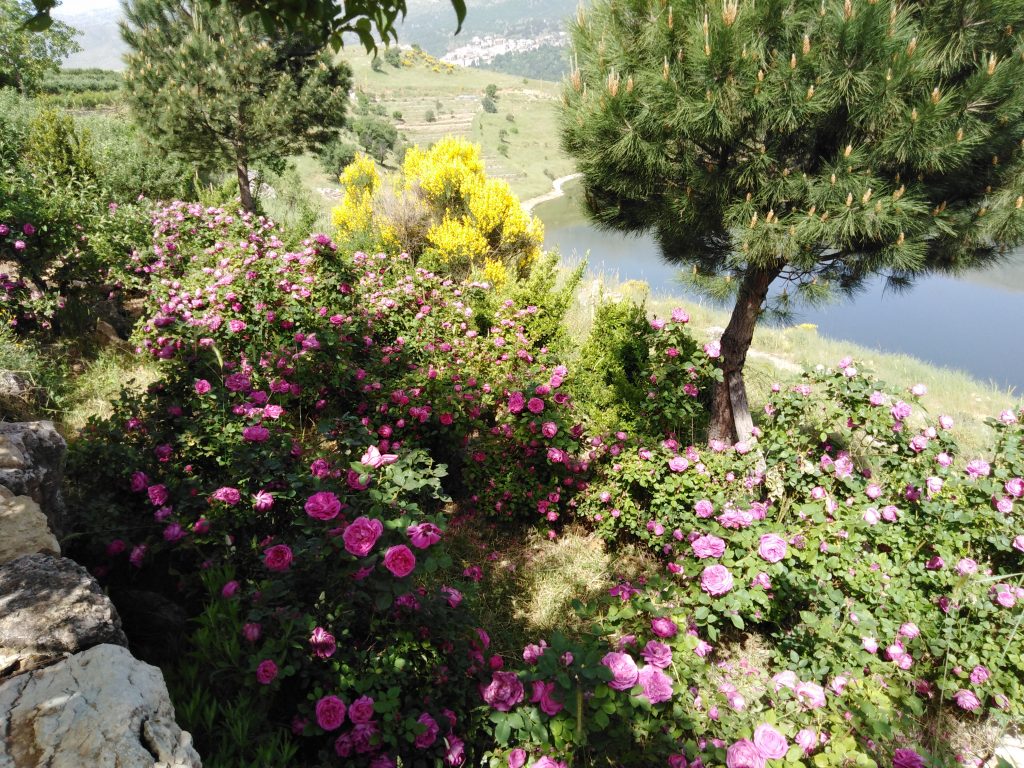Contributing writer: Camille CESBRON, Food Anthropologist
Rosa damascena mill L, commonly known as Damask rose is a hybrid from the Rosaceae family, mainly known for its intense fragrance. R. damascena is processed into rose water (mawared) and essential oils used in perfumes, rose jam and dried petals. Its name in English is Damask Rose after the Syrian capital, which given by the Crusaders when they brought back the rose in Europe. In Arabic, the rose is called Ward Joury (ورد جوري), most likely after the Iranian city of Jar where the rose originates from.

Earliest recordings of the culinary use of R. damascena were in Mesopotamia around the 7th century BCE; as per cuneiform tablets of the era attest, the rose was an essential ingredient in medical preparations and as well as in seasoning. Its cultivation gradually spread in the region, and noticeably in Persia where rose wine was made and exported as far back as 2,000 years ago. Persia started to distill roses to make rose water and essential oil and use them in medicine. Traditionally, rose water was used as an “antiseptic agent for eye washing and mouth disinfecting and as antispasmodic agent for alleviating the abdominal pains, and bronchial and chest congestions” (Mahloubi, M. 2016). According to the same source, rose petals decoctions were used for treatment of “abdominal and chest pains, strengthening the heart, menstrual bleeding, digestive problems and constipation”.

The social and almost “holy” connotations of the rose have a direct impact not just of abstract imaginaries but on practices too. The best example is found in Ancient Rome and Greece where Aphrodite (or Venus for the Romans), the goddess of love, beauty and passion is often associated with roses, influencing its use in food and drink preparations such as the use of essence or rose petals to season the wine.

In the book “Edible Flowers”, Constance L. Kirker and Mary Newman recall the wide spread use of roses in both sweet and savory dishes in History, making it an essential ingredient in the pantry: “By the tenth century rose water had become a commonly used flavor for cakes, cookies and pastries. During the medieval period, rose flavoring was used extensively in poultry, game and fish recipes.” The medicinal properties were the main reason of using R. damascena: In Medieval Times, food was systematically related to wellness and each ingredient would have healing or enhancing properties: roses were used for headaches and nausea. Nowadays, dried petals are widely used in the Middle East and Extreme Orient as it can be added to the za’atar mix (thyme mix) or in advieh (a mix of spices found in Iran and Iraq) and even the famous kammounieh in the South of Lebanon.
The village of Al-Mrah, north of Damascus is often cited as the epicentre of R. damascena cultivation, where each year, in May, a festival is organised in honour of the rose, and where the traditional craftsmanship of transforming rose into products has been listed in 2019 on UNESCO’s Representative List of the Intangible Cultural Heritage of Humanity.

R. damascena is widely produced in Lebanon where soil and climate seem to be favorable for its growth. The rose is planted on different altitudes ranging between 300 and 1500 m. In the village of Qsarnaba particularly, in the central Bekaa, roses are cultivated on high mountains, 1200m above sea level, and no irrigation is needed.
Harvesting roses is an intense daily job, concentrated on a period of 20 to 30 days in April-May. Farmers, with the help of family members or extra workers, pick the roses by hand in the evening or during very early morning hours at 5 am, to be delivered to customers within a 2-3 hours range. Roses wilt rapidly when they are cultivated where they lose their water. Hence, roses are placed in a refrigerator or in a cool place, until they sold.
Depending on the final product, roses are picked at different stages: They are either picked as whole flowers or as flower buds “زرار” (zrar) before blooming.
The current economic and health crisis has vastly affected the rose season this year. Due to the Covid-19 confinement and strict precautions, farmers in the Bekaa were not able to collect flowers on time, which resulted in a significant loss of production and resources. Rose production has increased while demand was stable, hence farmers were willing to sell roses at prices lower than the pricing set by the Ministry of Agriculture which is 5000 L.L per kilo.

To support local production, you can order your rose products from local producers and cooperatives around Lebanon:
Bekaa
Mawasem Day3tna (Sawsan Kassem), Qsarnaba: 76620061
Hajar Dirani, Qsarnaba: 71982484
Reymonda Nehme, Kherbet Qanafar: 03480035
Chouf
Couara (Mayssoun and Walid Nasreddin), Qfarqatra: 03424290
South
Mantoujat al Doha, Kfarsir: 71383076
References:
https://www.ncbi.nlm.nih.gov/pmc/articles/PMC3586833/
Davidson, A. (2014). The Oxford companion to Food (3rd. ed) Oxford: Oxford University Press.
Mahloubi, M. (2016) “Rosa damascena as holy ancient herb with novel applications” in Journal of Traditional and Complementary Medicine,Volume 6, Issue 1, pp. 10-16.
Newman, M. Kirker, C. L. (2016) Edible Flowers: A Global History. London : Reaktion Books.
